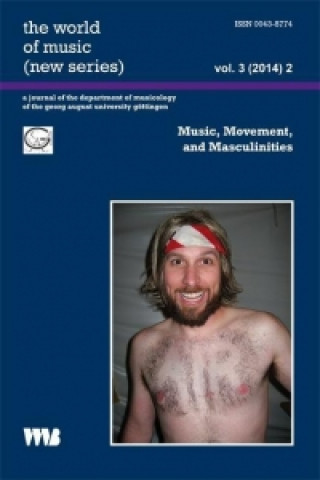
Kód: 12721526
Music, Movement, and Masculinities 3(2014) 2
Autor Birgit Abels
Despite influential recent scholarship on men in dance, the topic of bodily movement remains feminized in much of Western popular culture as well as in academia. Yet because gender is a construct that relies on perceptions of the ... celý popis
- Jazyk:
 Angličtina
Angličtina - Vazba: Brožovaná
- Počet stran: 172
Nakladatelství: VWB Vlg. F. Wissenschaft, 2015
- Více informací o knize

Mohlo by se vám také líbit
-

Dune
216 Kč -

Haunting Adeline
621 Kč -

Berserk Deluxe Volume 2
1092 Kč -

White Nights
89 Kč -

Powerless
268 Kč -

Atomic Habits
330 Kč -

Dune Messiah
228 Kč -

Berserk Deluxe Volume 3
1142 Kč -

One Day
221 Kč -

Berserk Deluxe Volume 1
1115 Kč -

Iron Flame
368 Kč -

Surrounded by Idiots
213 Kč -

Harry Potter and the Prisoner of Azkaban (Minalima Edition)
993 Kč -

Gravity Falls Journal 3
443 Kč -

Heaven Official's Blessing: Tian Guan Ci Fu (Novel) Vol. 1
420 Kč -

The Creative Act
568 Kč -

Dune
276 Kč -

Hunting Adeline
624 Kč -

A Little Life
290 Kč -

Children of Dune
230 Kč -

Heaven Official's Blessing: Tian Guan Ci Fu (Novel) Vol. 2
427 Kč
Informovat o naskladnění knihy
Zadejte do formuláře e-mailovou adresu a jakmile knihu naskladníme, zašleme vám o tom zprávu. Pohlídáme vše za vás.
Více informací o knize Music, Movement, and Masculinities 3(2014) 2
 Anotace knihy
Anotace knihy
Despite influential recent scholarship on men in dance, the topic of bodily movement remains feminized in much of Western popular culture as well as in academia. Yet because gender is a construct that relies on perceptions of the body, regardless of that body's gender, bodily movements provide keys to understanding how masculinities are constructed or questioned in different cultural contexts. This special issue seeks to understand how staged performances present or challenge ideals of masculinity, as well how masculine and feminine genders are constructed relationally through dance performance. It developed from a panel presented at the 2010 meeting of the Society for Ethnomusicology titled "Music, movement, and masculinities," but has since grown to include additional scholars. The issue will begin with an introduction contextualizing and commenting on the range of articles in the volume. In the first, author 1 suggests answers to the question of why ballet pas-de-deux gender protocols have failed to evolve, even in the face of numerous academic and choreographic critiques of ballet's gender roles. Next, author 2 examines the ironic portrayal of masculine rock stereotypes in competitive air guitar movements, demonstrating the genre's use as a bodily critique of rock's gender and racial constructions. The third contribution focuses on how capitalist realities have altered the ways in which Hungarian men creatively represent themselves through modern folk dance, while the fourth provides an analysis of the "official" masculinities displayed in Hungarian State Folk Ensemble choreographies. The fifth article challenges the construction of "oriental dance" as a feminine realm by demonstrating that male performers present a particular, orientalist type of masculinity. Finally, author 6 examines the performance of masculinities in ballet-based Ukrainian concert dance in Canada. As a whole, the proposed issue presents diverse views on contemporary masculine bodily expression from both established and emerging dance scholars, and it covers a broad range of geographic areas. Its examination of staged dance performances around the world, each of which aestheticizes masculinities in a different way, will be of interest to ethnomusicologists, dance ethnologists, folklorists, and performance studies scholars. In addition, it takes impetus from the current interdisciplinary interest in gesture studies, while pushing that field forward through its specific emphasis on masculine movements in popular, traditional, and classical musical contexts.
 Parametry knihy
Parametry knihy
- Plný název: Music, Movement, and Masculinities 3(2014) 2
- Autor: Birgit Abels
- Jazyk:
 Angličtina
Angličtina - Vazba: Brožovaná
- Počet stran: 172
- EAN: 9783861359081
- ISBN: 3861359081
- ID: 12721526
- Nakladatelství: VWB Vlg. F. Wissenschaft
- Hmotnost: 359 g
- Rozměry: 228 × 154 × 12 mm
- Datum vydání: January 2015
Osobní odběr Praha, Brno a 12903 dalších
Copyright ©2008-24 nejlevnejsi-knihy.cz Všechna práva vyhrazenaSoukromíCookies



 Vrácení do měsíce
Vrácení do měsíce 571 999 099 (8-15.30h)
571 999 099 (8-15.30h)